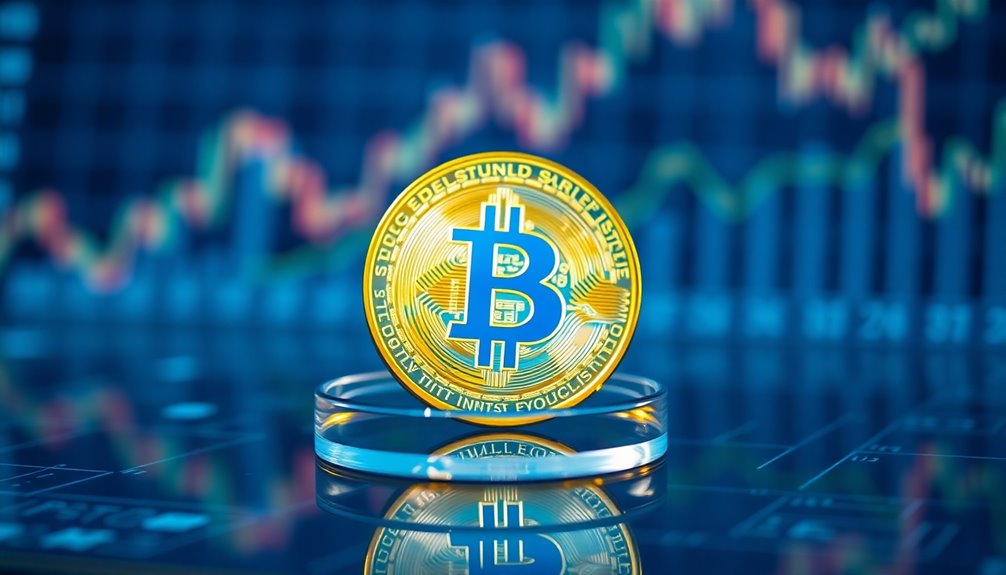Tokenomics is the economic structure behind a cryptocurrency, focusing on its supply, distribution, and utility. It directly impacts the project's growth potential and overall market position. You'll find that tokenomics involves understanding supply-demand dynamics, like maximum and circulating supply, which influence price stability. It also includes distribution methods and community incentives that keep participants engaged. The assessment of tokenomics helps you gauge long-term sustainability and viability. By understanding these elements, you can make more informed decisions about investing. There's much more to uncover about how tokenomics shapes the crypto landscape and its implications for you.
Key Takeaways
- Tokenomics is the economic model of a cryptocurrency, encompassing its supply, distribution, and utility.
- It plays a crucial role in assessing the growth potential and sustainability of crypto projects.
- Token supply dynamics include maximum supply, total supply, and circulating supply, affecting market stability and price fluctuations.
- Distribution mechanisms such as airdrops and paid sales influence stakeholder engagement and community trust.
- The utility of tokens can drive demand and investor sentiment, impacting overall token value and market volatility.
Token Supply and Demand

When exploring tokenomics, understanding token supply and demand is crucial, as it directly impacts a token's value and market dynamics.
The maximum supply sets a cap, while the total supply accounts for all existing tokens, including those burned or locked. Circulating supply reflects how many tokens are actively traded.
Factors like mining rewards and token burn mechanisms can influence these numbers, altering the overall supply. Additionally, well-designed tokenomics can drive economic growth and active participation in blockchain ecosystems, fostering a self-sustaining environment.
On the demand side, tokens with utility in governance or staking typically attract more interest. Market sentiment and investor confidence also play vital roles.
Ultimately, the interplay of supply and demand determines price fluctuations and market stability, making it essential to grasp these concepts for informed investment decisions.
Understanding Token Economic Principles

Understanding token economic principles is vital for anyone looking to navigate the complexities of cryptocurrency. These principles govern how tokens are created and their specific utilities within a blockchain network.
The cryptocurrency's whitepaper outlines the creation process, defining how tokens incentivize behaviors and contribute to the network's value. A well-crafted economic model considers supply, demand, and market cap, encouraging long-term holding rather than speculation. This model promotes sustained use and investment, enhancing the token's worth. Incentives play a crucial role, encouraging desired actions while discouraging the undesired, shaping participant interaction. Additionally, the effectiveness of these tokens can be enhanced by incorporating elements from a token economy that reinforce positive behaviors and engagement within the community.
Token Distribution Mechanisms Explained

Token distribution mechanisms play a crucial role in shaping a cryptocurrency's success and community engagement. You'll encounter two primary models: paid and free-of-charge.
In paid models, tokens are sold through private and public sales, often involving a pre-sale to venture capitalists. On the other hand, free-of-charge models distribute tokens via airdrops or staking rewards, ensuring broader community participation.
Allocation and vesting also matter. Tokens are typically divided among stakeholders, with set percentages for teams, investors, and advisors. Vesting schedules ensure long-term commitment, releasing tokens gradually. Additionally, engaging legal experts to navigate regulatory compliance is essential to avoid potential fines or lawsuits.
Transparency is key; knowing the allocation percentages and vesting periods helps build trust. Lastly, fair distribution methods prevent early whales from dominating the market, creating a more inclusive opportunity for all participants.
Pros and Cons Overview

Navigating the landscape of tokenomics involves weighing both the advantages and disadvantages that come with it.
On the plus side, tokenomics can foster unique and transparent projects governed by clear rules, providing a secure environment for development. Tokens can also be invested in, granting owners rights and adding value. Understanding the economic models behind tokenomics can further enhance investor confidence in the project's potential.
However, complexity and regulatory challenges can make understanding tokenomics tough, potentially impacting a token's acceptance. Market volatility may arise, leading to speculation rather than long-term holding. Additionally, inflationary or deflationary risks can threaten value stability. Lastly, a project's success often hinges on network adoption; without it, you might find limited real-world utility, discouraging investment.
Balancing these factors is essential for navigating tokenomics effectively.
Tokenomics vs. Traditional Economics

While both tokenomics and traditional economics aim to manage resources and incentivize participation, they operate under fundamentally different principles and structures.
In tokenomics, you'll find decentralized control where governance involves all token holders, ensuring transparency through blockchain technology. Traditional economics, on the other hand, relies on centralized authority, concentrating decision-making power within a few entities.
Tokenomics features dynamic incentive mechanisms built into protocols, rewarding contributions like mining and validating transactions. This adaptability allows for various token supply models and rapid responses to market shifts, making it essential to consider token supply models that can align with user demand. In contrast, traditional economics struggles with flexibility and often lacks the integration of emerging technologies.
Market Volatility Impacts Token Value

Market volatility plays a significant role in determining token value, influenced by various factors that can shift rapidly. Your token's worth is sensitive to the overall state of the cryptocurrency market and investor sentiment. If demand outpaces supply, prices can soar, while a lack of interest can lead to sharp declines. Liquidity also affects how reliably you can trade tokens; low liquidity often results in greater price swings. Additionally, specific aspects of the token, like its usefulness, total supply, and community engagement, can further drive volatility. Keep an eye on regulatory changes and technological advancements, as they can significantly impact market perception and, consequently, your token's value. Understanding these dynamics helps you navigate the unpredictable crypto landscape. Furthermore, higher utility value in tokens used in popular decentralized exchanges can enhance their resilience against market fluctuations.
Decentralized Finance (DeFi) Growth

As decentralized finance (DeFi) continues to evolve, its growth trajectory is nothing short of remarkable.
You'll see the DeFi market is projected to reach a staggering $700 billion by the end of 2025, an 8x increase from current levels. This growth stems from rising cryptocurrency adoption and enhanced access to financial services, with annual revenues expected to soar from $1 billion to over $5 billion in the same timeframe. Additionally, the DeFi market cap represents a significant portion of the overall financial ecosystem, highlighting its potential impact on traditional finance.
Key drivers include the emergence of decentralized lending and trading platforms, alongside the integration of NFTs and cross-chain solutions. Innovations like decentralized exchanges and yield farming are transforming the landscape, making DeFi an enticing space for mainstream investors and promising sustained momentum in the coming years.
Analyze Competitor Token Models

Understanding how different blockchain projects structure their token models can give you valuable insights into their potential for growth and sustainability.
For instance, Ethereum's initial supply of over 72 million ETH was primarily purchased by investors, and it now plays a crucial role in gas fees and staking rewards. Ethereum (ETH) is a decentralized platform that enables smart contracts and decentralized applications, contributing to its extensive use case and value.
Solana, with over 431 million SOL tokens in circulation, uses a Proof of History mechanism, allowing for high transaction throughput.
Meanwhile, Flow allocated 29% of its 1.25 billion FLOW tokens to rewards, emphasizing community engagement.
Binance Coin (BNB), initially an ERC-20 token, thrives through trading fee discounts.
Analyzing these models helps you understand market positioning, utility, and the distinct advantages each token brings to its ecosystem.
Frequently Asked Questions
How Do Regulatory Changes Affect Tokenomics?
Regulatory changes can significantly impact your tokenomics. They might alter how tokens are distributed, affecting allocations for your development team and advisors.
Compliance with new regulations can enhance your token's legitimacy and acceptance, influencing its utility and usage.
These changes might also shift market dynamics, affecting demand, liquidity, and overall value.
Staying informed on regulatory developments will help you adapt your strategies and maintain credibility in the evolving landscape.
What Role Do Community Incentives Play in Tokenomics?
You could say community incentives are the secret sauce of a thriving ecosystem.
By fostering active participation and aligning interests, these incentives encourage users to engage with the project long-term. When you feel valued and rewarded, you're more likely to contribute and support the community.
This creates a positive feedback loop, enhancing collaboration and trust, which ultimately strengthens the entire project.
Everyone wins when incentives align with shared goals and aspirations.
Can Tokenomics Models Evolve Over Time?
Yes, tokenomics models can definitely evolve over time.
You'll find that they adapt to market conditions, respond to user feedback, and incorporate technological advancements. As economic landscapes shift, adjustments in supply and demand dynamics become essential.
Regulatory changes also play a crucial role, prompting necessary updates. By staying attuned to community needs and market trends, you can ensure a token's design remains relevant and effective in driving engagement and value.
How Do Tokens Influence User Engagement?
Just like a well-crafted tale, tokens shape user engagement through their utility and perceived value.
When you see a token as a key to unlock exclusive features or rewards, you're more likely to participate actively. If the distribution feels fair, and the incentives resonate with your interests, you're drawn into the ecosystem.
Ultimately, a vibrant community around the token fuels your enthusiasm, encouraging you to hold and engage consistently.
What Metrics Are Best for Evaluating Tokenomics?
To evaluate tokenomics effectively, focus on key metrics like maximum supply, circulating supply, and token issuance.
You'll want to assess token distribution, including how investors receive their shares and any unlock schedules.
Also, consider demand drivers, such as use cases and network activity.
Finally, analyze performance metrics like liquidity ratio and market cap to understand the token's overall health and potential risks.
These insights will guide your investment decisions.
Conclusion
In conclusion, tokenomics turns traditional thinking on its head, transforming how we view value and distribution. By diving into demand dynamics and distribution designs, you can better grasp the growing world of digital currencies. As decentralized finance continues to flourish, staying savvy about token trends and competitors is crucial. Embrace the exciting evolution of economics and explore how tokenomics can shape your financial future. Stay curious, and keep contemplating the captivating complexities of this new frontier!









